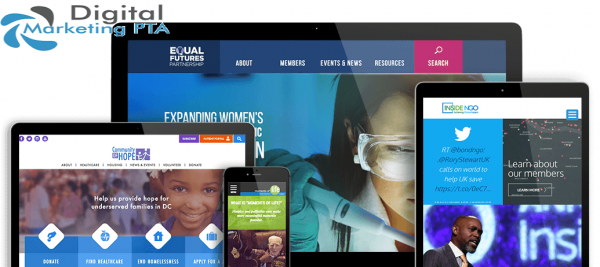A Comprehensive Overview to Responsive Web Layout Methods
Responsive internet design has actually become an essential part in the development of electronic platforms, enabling for a seamless individual experience throughout a wide variety of devices. This guide will certainly explore important techniques such as liquid layouts, media inquiries, and photo optimization that add to reliable responsive style. By understanding these concepts, designers can produce internet sites that not only adjust aesthetically but additionally boost user interaction. However, the landscape of website design is constantly developing, elevating questions about the future of responsiveness and the methods that will certainly define it.
Comprehending Responsive Internet Layout
Receptive website design (RWD) is a strategy that ensures a website's layout and content adapt flawlessly throughout a selection of tools and display sizes (Web Design Pretoria). This design methodology is important in today's digital landscape, where users accessibility internet sites from smart devices, tablet computers, laptops, and home computer. RWD boosts individual experience by enabling a site to maintain capability and visual appeals, despite the tool being utilized
An essential component of RWD entails fluid grids that use loved one systems, such as portions, instead of taken care of systems, to define design elements. This adaptability allows images, message, and other parts to resize proportionally, supplying an ideal watching experience. Furthermore, media queries are used to apply various designs based on gadget qualities like display width and alignment. This technique guarantees that the internet site's style is customized to the certain demands of individuals, boosting functionality.
Additionally, RWD adds positively to look engine optimization (SEARCH ENGINE OPTIMIZATION) by promoting a solitary, regular URL for a web site, which streamlines link sharing and indexing. As smart phone use continues to increase, recognizing and implementing responsive website design is vital for businesses intending to get to a more comprehensive audience and enhance total internet efficiency.
Key Principles of Responsive Style
To create a reliable receptive layout, numerous vital concepts need to be thought about. This indicates creating for the smallest screens first and considerably boosting the format for bigger gadgets.
Second, flexible grids and formats are essential. Making use of a grid system that adjusts to different screen dimensions permits an unified distribution of content, ensuring readability and use throughout gadgets. This adaptability is complemented by the usage of family member systems, such as ems or percents, instead of taken care of pixels.

Last but not least, prioritizing material hierarchy is necessary. Clear and rational organization of material boosts user experience, assisting site visitors through the website flawlessly, despite the gadget made use of. Web Design Pretoria. By adhering to these concepts, developers can create websites that are not just aesthetically appealing however additionally functional and user-centered throughout all devices
Methods for Liquid Layouts
Liquid layouts are vital for developing flexible web experiences that perfectly adapt to numerous display dimensions. By utilizing percentage-based widths as opposed to taken care of pixel worths, developers can ensure that elements on a website resize proportionally, preserving aesthetic consistency Going Here throughout tools. This strategy advertises adaptability, allowing content to stream and adapt as the viewport modifications.
One reliable method for index achieving fluid layouts is to employ CSS Flexbox or Grid systems. These CSS components allow designers to produce responsive structures that can easily resize and reorganize based on the available space. Flexbox excels in one-dimensional formats, while Grid is ideal for two-dimensional arrangements, providing greater control over positioning and placement.
An additional strategy includes utilizing media inquiries to define breakpoints where changes are essential - Web Design Pretoria. By defining different styles for numerous display dimensions, designers can change layout residential or commercial properties dynamically, making certain ideal use and aesthetic appeal
In addition, including family member units like ems or rapid eye movements for font dimensions and spacing can better boost fluidness, as these systems range based on user setups or parent elements. With each other, these methods facilitate the growth of liquid designs that promote an interesting individual experience across varied devices.
Maximizing Pictures for All Instruments
Pictures play an important role in website design, and maximizing them for various tools is vital for enhancing performance and customer experience. To accomplish this, developers ought to use responsive photo techniques that make sure images show appropriately across various screen sizes and resolutions.
One reliable method is utilizing the HTML" element, which permits defining multiple picture sources based on the display screen conditions. This Site By utilizing 'srcset' features, developers can supply various image resolutions, allowing the internet browser to select the most proper one for the user's device.
Furthermore, applying proper data layouts is important. Styles such as JPEG, PNG, and WebP each offer distinctive purposes and can substantially influence loading times. WebP, for example, provides remarkable compression, bring about smaller file sizes without compromising high quality.
An additional essential aspect is image compression. Tools like TinyPNG or ImageOptim can decrease file sizes, improving packing speed while protecting visual stability. Making use of CSS for history photos can enhance packing as they can be controlled much more fluidly across devices.
Ultimately, maximizing photos not just improves site performance yet additionally adds to much better individual engagement and retention, making it a fundamental technique in receptive website design.
Testing and Keeping Responsiveness
Guaranteeing a smooth customer experience across various tools needs persistent testing and upkeep of responsiveness. The very first step in this procedure is to use a combination of guidebook and automated testing devices. Tools such as Google's Mobile-Friendly Examination and BrowserStack enable developers to sneak peek exactly how their sites execute across multiple tools and screen dimensions successfully.
Furthermore, it is important to perform normal audits of your site's format and capability. This includes monitoring for breakpoints, guaranteeing components resize properly, and validating that navigating remains user-friendly. Testing must not be limited to visual aspects; performance throughout various internet browsers and devices need to be examined to determine any kind of discrepancies.

Final Thought
Finally, the execution of receptive internet layout techniques is important for producing adaptable sites that improve individual experience throughout varied gadgets. By sticking to crucial concepts such as liquid grids, media questions, and adaptable formats, in addition to maximizing photos and making use of receptive structures, developers can accomplish visual charm and enhanced loading rates. Recurring screening and upkeep additional make sure that web sites stay practical and aesthetically pleasing, ultimately adding to increased customer involvement and contentment.
Receptive web design has actually ended up being an important component in the growth of digital systems, permitting for a smooth customer experience throughout a plethora of devices.Receptive internet layout (RWD) is a method that ensures a web site's layout and web content adapt seamlessly throughout a variety of gadgets and display sizes. RWD boosts individual experience by permitting a site to keep performance and visual appeals, no matter of the device being used.
Making certain a seamless individual experience throughout different tools requires thorough screening and maintenance of responsiveness.In verdict, the implementation of responsive internet design methods is crucial for producing versatile internet sites that enhance individual experience throughout diverse devices.
Comments on “Inexpensive Options for Quality Web Design Pretoria for Startups”